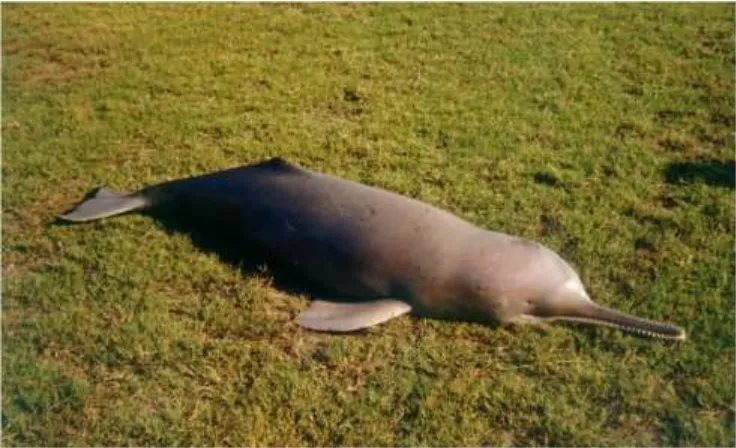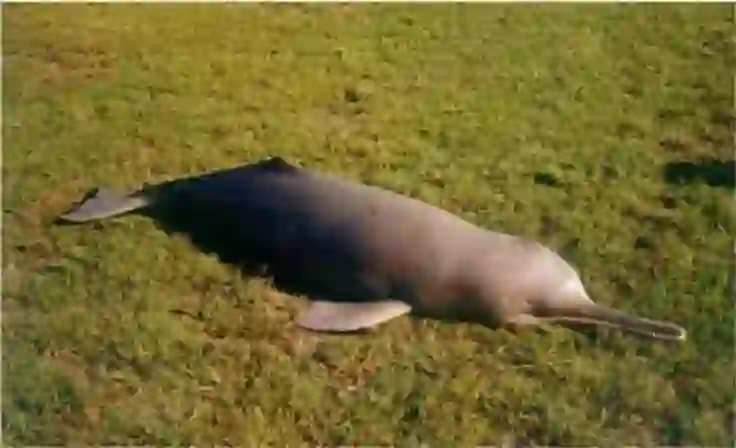
Indus River Dolphin
Indus River Dolphin
Indus River Dolphin
In the murky waters of the Indus River in Pakistan, lives a blind dolphin: the Indus river dolphin. These dolphins, also known as 'bhulan' in the local language, are fighting for survival despite the threats they face. Let's delve into the unique ecology of the Indus river dolphin and the efforts to protect them.
Indus River Dolphin Basic Infomation

| Property | Value |
|---|---|
| Scientific Name | Platanista minor |
| Taxonomic Status | ACCEPTED |
| Rank | SPECIES |
| Vernacular Names | Indus River Dolphin |
| Kingdom | Animalia |
| Phylum | Chordata |
| Class | Mammalia |
| Order | Cetartiodactyla |
| Family | Platanistidae |
| Genus | Platanista |
| Habitats | Indus River basin |
| Conservation Status | Endangered (EN) |

Size
They are about 8.2 feet (2.5 meters) long and weigh up to 200 pounds (90 kilograms). Females are slightly larger than males.

Lifespan
Their lifespan in the wild is estimated to be about 28 years.

Distribution
They are found only in the Indus River basin in Pakistan. They were once widely distributed throughout the Indus River and its tributaries, but their numbers have drastically declined, and they are now found only in a few sections of the main Indus River.
Indus River Dolphin Q&A

What kind of dolphin is the Indus river dolphin?
The Indus river dolphin is a species of river dolphin that belongs to the family Platanistidae and the genus Platanista.
They are endemic to the Indus River in Pakistan. They have a long beak, small eyes, and a brownish body. They are also known as the 'blind river dolphin' due to their very poor eyesight. They navigate and find food using echolocation. They are usually solitary or travel in small groups of a few to a dozen individuals. They feed on fish and shrimp.

What do Indus river dolphins eat?
Indus river dolphins are carnivores, and their diet consists mainly of fish, such as carp and catfish, and crustaceans like shrimp and crabs.
They use their long beak to probe the muddy river bottom, searching for fish. They also use echolocation to locate prey. By emitting sound waves, they can understand their surroundings and pinpoint the location of their prey. This ability allows them to hunt effectively, even in murky water.

[Quiz!] Why do Indus river dolphins have such small eyes?
Indus river dolphins have very small eyes compared to other dolphins.
This is because they evolved in the murky waters of the Indus River, where vision is not very useful. They have adapted to rely on echolocation, rather than sight, to navigate and find food. Their eyes can detect light, but they cannot see the shapes of objects clearly. It's almost as if they are living blindfolded. Despite this, they are able to skillfully navigate the river, catch prey, and raise their young using their echolocation abilities.

[Quiz!] Are Indus river dolphins endangered?
Yes, the Indus river dolphin is listed as 'Endangered' (EN) on the IUCN (International Union for Conservation of Nature) Red List.
Their numbers have been declining in recent years. This is mainly due to human activities:
・Water pollution: The water quality of the Indus River is deteriorating due to industrial wastewater, sewage, and agricultural pesticides.
・Bycatch: They can be accidentally caught in fishing nets.
・Dam construction: Many dams have been built on the Indus River, fragmenting their habitat.
・Hunting: They are hunted for their meat, oil, and teeth in some areas.
To protect Indus river dolphins, we need to reduce water pollution, minimize bycatch, regulate dam construction, and ban hunting. It is important to learn about the plight of the Indus river dolphin and consider what we can do to help.

Would you like to become a part of the 'Animalbook.jp'?
Turn your knowledge into Q&A and share it with the world. ※Publication will be activated after purchase. Let's share information together!
Indus River Dolphin Type of List

Characteristics of Indus River Dolphins
- Long beak
- Small eyes
- Nearly blind
- Brownish body color
- About 8.2 feet (2.5 meters) long
- Weigh up to 200 pounds (90 kilograms)
- Live only in the Indus River basin in Pakistan
- Endangered (EN)
Information
Congratulations! You are the first commenter!

Create Your Favorite List!
Indus River Dolphin
Save the animals you love! Build your own list to quickly revisit your favorites later.

Would you like to leave a comment?
※Please note: This is for the purchase of rights to post comments within the article.
Find Your Favorites!
Our shop offers a unique and attractive selection of goods themed around various animals.
Indus River Dolphin References
Indus River Dolphin Introduction of media used

Christina H Lockyer and Gill T Braulik, CC BY 3.0, ウィキメディア・コモンズ経由で

Christina H Lockyer and Gill T Braulik, CC BY 3.0, ウィキメディア・コモンズ経由で

Help Enrich Our Animalbook.jp with Your Media!
We are constantly looking to expand and enrich our Animalbook.jp with amazing photos and videos of animals. If you have any media that you'd like to share, please contribute and help us showcase the beauty and diversity of the animal kingdom. Your submissions will be credited and featured in our encyclopedia, reaching a wide audience of animal lovers.


















